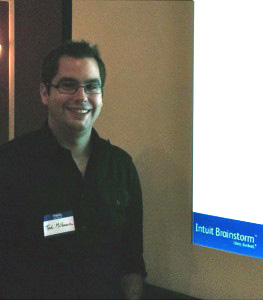INNOVATION AT INTUIT: BRAINSTORM
/This week's Bay Area CIO IT Executives Meetup Group focused on innovation at Intuit -- the folks that bring us TurboTax, Quicken, and QuickBooks. Tad Milbourn, our presenter, is the lead on their Brainstorm project. Tad described the inception of Brainstorm as an internal innovation itself, the development of Brainstorm for supporting innovation at Intuit, and now how Brainstorm is becoming a product for the rest of us. (For more on Brainstorm, including screenshots, please also see Bill Ives' post.)

Tad and his colleagues were relatively new to Intuit and looking for a way to spend their "10% unstructured" time. They noted that Intuit had an innovation tool -- but that it was built for executive reporting, not for innovators. They also noted that from 1998 to 2007, Intuit had an innovation rate of 4 per year. This didn't sound like a good innovation environment to them.
The Brainstorm story is an example of systems savvy and ongoing TOP Management -- and goes to show that you don't have to have decades of experience to have savvy. They saw that the current tool wasn't a fit to the innovators' needs, nor Intuit's values around tools, culture, and process. They had the motivation to give it a go. They managed the technology, organization, and people. (For an example of what could have happened if they didn't practice TOP Management, see this post.) It was by tying these issues together that they built a solid platform and were able to engage innovators from around the world and across functional areas. They were innovators building a tool for other innovators. They knew that such a tool would need to:
- Get insights from all over the company, not just within obvious silos
- Grow ideas
- Find and link together people with needed skills -- and not just skills that formally showed up via title or job experience.
- Keep the energy alive through on-going conversations, notifications of edits and comments, the ability to follow a person, idea, or tag
- Get management attention when the time is right
- ...and still work within standard operating procedures (you can submit ideas via email as well as through the web tool)
They also knew that every idea is different and that the idea's "space" would need to be easily customizable. They built in modules that can be linked together like Legos (e.g., a to-do list, a calendar, a list of team members -- similar to the self-design possible in a Google Site). The new tool even meets the executive reporting needs better than did the old one. The data is more realistic in that it is more tightly tied to the reality of the innovation's progress. Innovation leaders within each group can see a dashboard of activity, giving them real-time understanding of innovation progress.
Final result: Tad reports that ideation is up 1000%, participation in innovation is up 500%, and they are running a rate of 20+ innovations/year (versus 4). They now have two external clients using Brainstorm. At one client they gained 40% adoption in 6 weeks.






